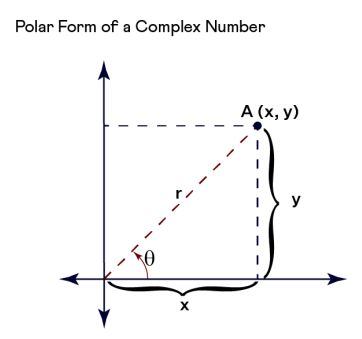How to Find the Polar Form of Complex Numbers?
The polar form of complex numbers is another way to display complex numbers. Here, you will learn more about finding the polar form of complex numbers.

Complex numbers can be represented in polar form, which is a different approach than rectangular form. Complex numbers are typically represented as \(z = x+iy\), where \((x, y)\) is the rectangular coordinates.
Related Topics
- Identities of Complex Numbers
- How to Find Distance and Midpoint of Complex Numbers
- How to Solve the Complex Plane
Step by step guide to the polar form of complex numbers
Complex numbers are expressed in polar form as the combination of the modulus \(r\) and the complex numbers argument \(θ\). With coordinates of \((x,y)\), we can express the complex number in the manner of \(\color{blue}{z = r cos θ +i\ r sin θ= r ( cos θ + i\ sin θ )}\).
The polar form is represented with the help of polar coordinates of real and imaginary numbers in the coordinate system. Complex number \(A = x+i y\) in two-dimensional coordinate system:

- In this image above, we have:
\(\color{blue}{cos\ θ=\frac{x}{r}}\) ⇒ \(\color{blue}{x=r cos\ θ }\)
\(\color{blue}{sin\ θ=\frac{y}{r}}\) ⇒ \(\color{blue}{y=r sin\ θ }\)
- And using Pythagoras theorem,we have:
\(\color{blue}{r^2=x^2+y^2}\) ⇒ \(\color{blue}{r=\sqrt{(x^2+y^2)}}\)
\(\color{blue}{tan\ θ=\frac{y}{x}}\) ⇒ \(\color{blue}{θ=tan^{-1}(\frac{y}{x})}\)
- For example, the horizontal and vertical axes are known as the real and imaginary axes.
- In the complex number polar form, \(r\) is the length of the vector, and \(θ\) is the angle it makes with the real axis.
- A point with coordinates \(A\) exists \((x, y)\).
- As you can see, \(r\) is the distance from \((0,0)\) to point \(A\).
- The line connecting \(A\) with origin produces a \(90\)-degree angle with a positive \(x\)-axis.
- As you can see, the polar coordinates \((r, θ)\) and the rectangle coordinates \((x, y)\) are both listed here \((x, y)\).
Complex-number polar form equation
With coordinates of \((x,y)\), we can express the complex number in the manner of \(z = r cos θ +i\ r sin θ = r ( cos θ + i\ sin θ )\). The abbreviated polar form of a complex number is \(z=r\ cis θ \), where \(r=\sqrt{(x^2+y^2)}\), and \( θ =tan^{-1}\frac{y}{x}\).
The polar form of a complex number has the following components:
- The absolute value of a complex number is represented by the symbol \(r\).
- Angle \(θ\) – The complex number argument is called the angle.
The Polar Form of Complex Numbers – Example 1:
Write the complex number in polar form. \(5+3i\)
First, find the absolute value of \(r\) by using this formula: \(\color{blue}{r=|z|=\sqrt{(x^2+y^2)}}\)
\(r=\sqrt{(5^2)+(3)^2} =\sqrt{25+9}=\sqrt{34}\)
\(r=\sqrt{34}≈5.83\)
Then, find the argument \(θ\) by using this formula: \(\color{blue}{θ=tan^{-1}(\frac{y}{x})}\).
\( θ =tan^{-1}(\frac{3}{5})=arctan(\frac{3}{5})=0.54\)
Now, write the polar form by using this formula: \(\color{blue}{z =r ( cos θ + i\ sin θ )}\).
\(z=5.83(cos(0.54)+i\sin(0.54))\)
The Polar Form of Complex Numbers – Example 2:
Write the complex number in polar form. \(3+4i\)
First, find the absolute value of \(r\) by using this formula: \(\color{blue}{r=|z|=\sqrt{(x^2+y^2)}}\)
\(r=\sqrt{(3^2)+(4)^2} =\sqrt{9+16}=\sqrt{25}\)
\(r=\sqrt{25} = 5\)
Then, find the argument \(θ\) by using this formula: \(\color{blue}{θ=tan^{-1}(\frac{y}{x})}\).
\( θ =tan^{-1}(\frac{4}{3})=arctan(\frac{4}{3})=0.92\).
Now, write the polar form by using this formula: \(\color{blue}{z =r ( cos θ + i\ sin θ )}\).
\(z=5(cos(0.92)+i\sin(0.92))\)
Exercises for the Polar Form of Complex Numbers
Write the complex number in the polar form.
- \(\color{blue}{5i}\)
- \(\color{blue}{-3+3i}\)
- \(\color{blue}{2+i}\)
- \(\color{blue}{3+7i}\)

- \(\color {blue}{z=5(cos(\frac{π}{2})+i sin(\frac{π}{2}))}\)
- \(\color {blue}{z=3\sqrt{2}(cos(\frac{-π}{4})+i sin(\frac{-π}{4}))}\)
- \(\color {blue}{z=\sqrt{5}(cos(0.46)+i sin(0.46))}\)
- \(\color {blue}{z=\sqrt{58}(cos(1.16)+i sin(1.16))}\)
Related to This Article
More math articles
- Top 10 ALEKS Math Prep Books (Our 2023 Favorite Picks)
- 10 Most Common 4th Grade MAP Math Questions
- Best Calculators for Linear Algebra and Calculus
- How Do You Pass the CBEST Math?
- Top 10 Tips to Overcome CBEST Math Anxiety
- Weight Measurements
- Top 10 6th Grade STAAR Math Practice Questions
- The Ultimate ACCUPLACER Math Formula Cheat Sheet
- How to Find the Solutions: “Pre-Algebra for Beginners” Detailed Answer Manual
- 4th Grade KAP Math Worksheets: FREE & Printable
























What people say about "How to Find the Polar Form of Complex Numbers? - Effortless Math: We Help Students Learn to LOVE Mathematics"?
No one replied yet.